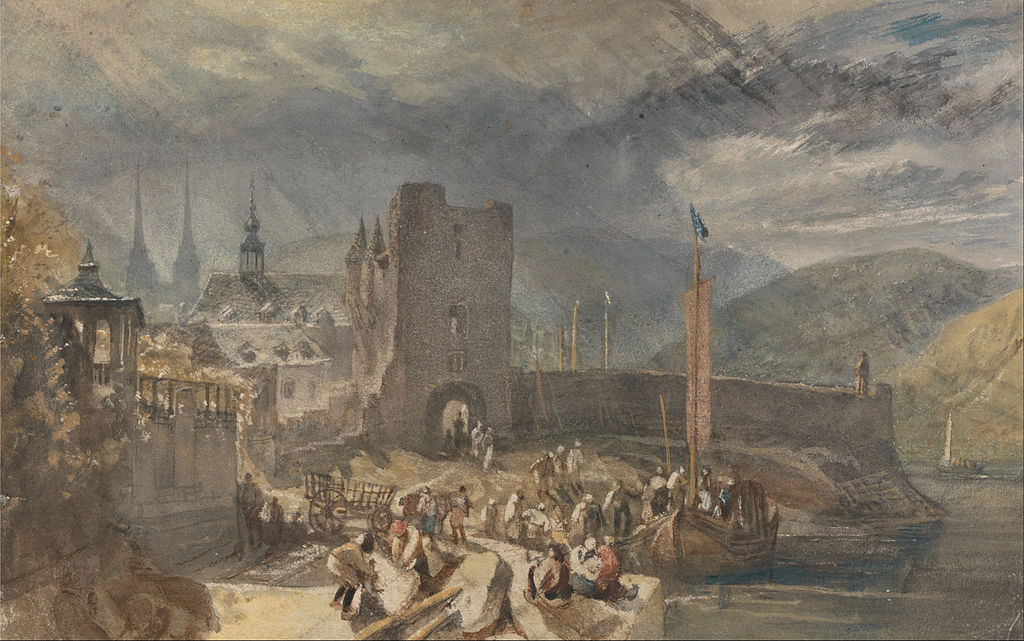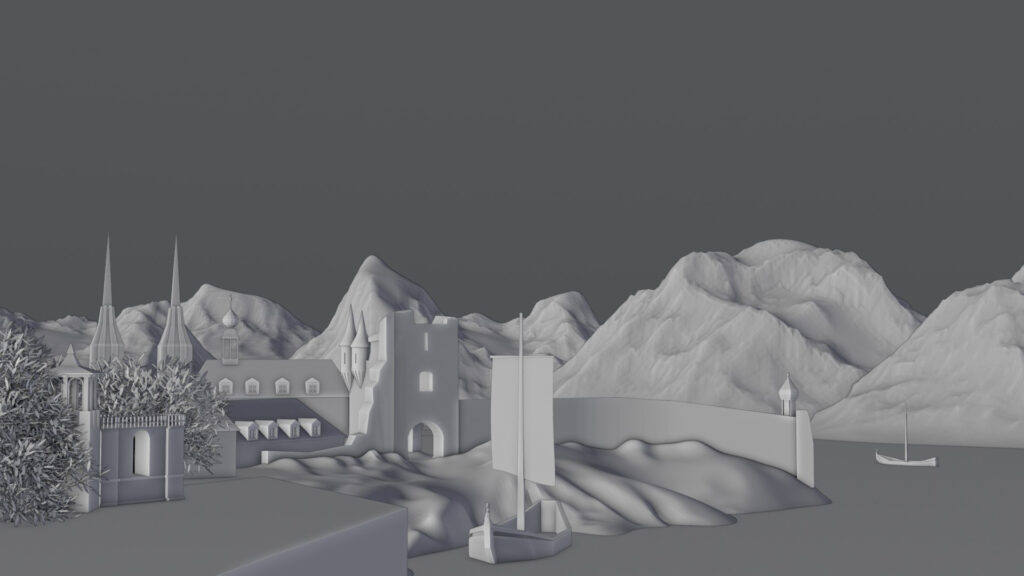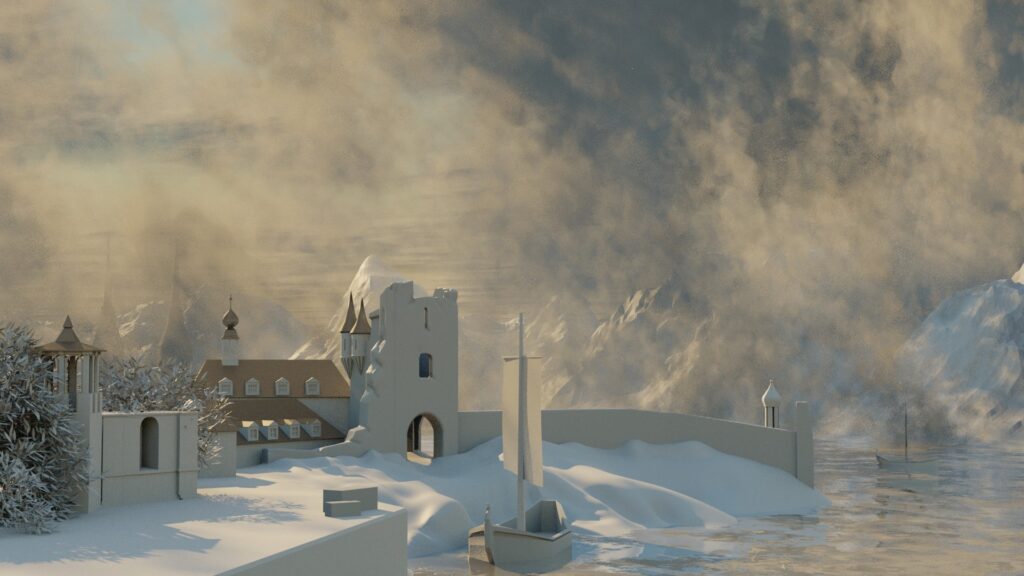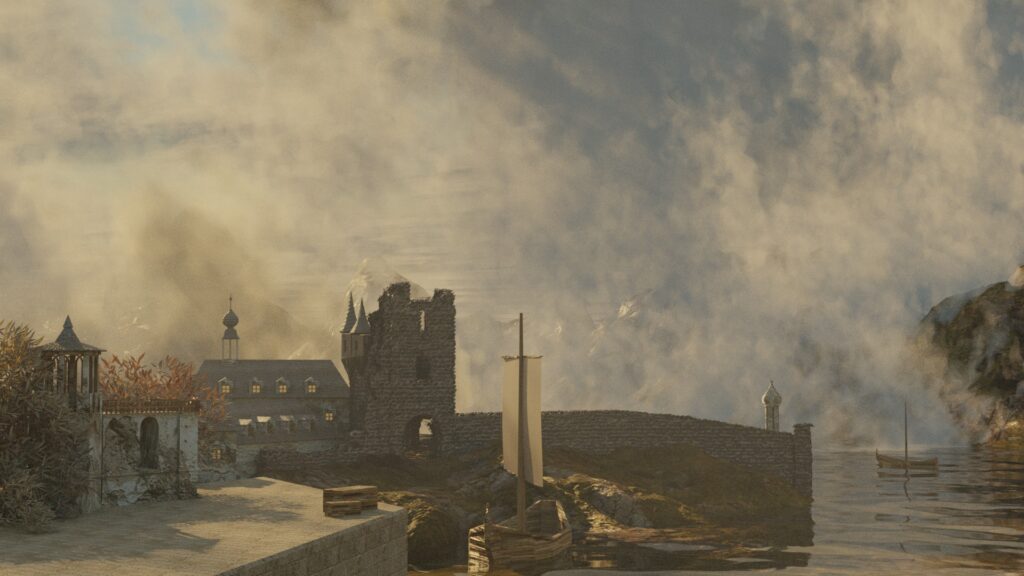Prelude: In early 2024, I was invited to contribute an essay to an edited volume on Rheinromantik (Romanticism of the Rhine). To approach this subject, and particularly to relate it to media theory, I developed a series of experiments focused on a visual/atmospheric phenomenon that had significant consequences for the art produced in the years after 1816. For me, such experiments are essential; they allow me to explore the subject from different angles and generate ideas for a theoretical contribution through these initial investigations.
Exploring the evocative imagery of the Rhine Romantic period has led me down an intriguing path, particularly as I examine the works of William Turner. His depictions of the Rhine region are especially fascinating, capturing a distinct atmosphere shaped by the peculiar conditions of 1816—the ’Year Without a Summer’. The global effects of the 1815 eruption of Mount Tambora in Indonesia introduced fine particles into the atmosphere, giving rise to vivid, hazy sunsets and an ethereal light quality, which Turner captured masterfully. This article details my attempt to recreate such conditions using modern 3D rendering tools.

The Role of Atmospheric Particulates in Visual Perception
One of the most remarkable realizations that struck me during this project was how profoundly atmospheric particles can alter the mood of a spatial scene. To explore this, I used 3D rendering to simulate the visual effects of these suspended particles in the air. Below, you’ll find two renders of the exact same scene—the only difference being the presence or absence of light-scattering particles in the atmosphere.

In the first rendering, light-refracting particles were added to the air volume. This treatment dramatically transforms the scene, revealing how turbidity and suspended aerosols can change not only color shifts but also the perceived depth and mood of the landscape.

For the second render, I removed the light-scattering particles. The difference is striking: the crispness of the image and the harsh contrasts result in a completely different atmosphere. While these elements were not ultimately included in my dissertation, I find the concept deeply relevant to the broader question of how light itself becomes visible. Even Goethe pondered this in §326 of his Theory of Colors, noting that dust or smoke in the air is essential to make light perceptible.
German original from Goethes Farbenlehre
Wenn man das aus dem Prisma heraustretende leuchtende Bild und seine wachsende Farbenerscheinung auf einer entgegengehaltenen Tafel stufenweise beobachten, und sich Durchschnitte von diesem Conus mit elliptischer Base vor Augen stellen kann; so läßt sich auch das Phänomen auf seinem ganzen Wege zum schönsten folgendermaßen sichtbar machen. Man errege nehmlich in der Linie, in welcher das Bild durch den dunklen Raum geht, eine weiße feine Staubwolke, welche durch feinen recht trocknen Haarpuder am besten hervorgebracht wird. Die mehr oder weniger gefärbte Erscheinung wird nun durch die weißen Atomen aufgefangen und dem Auge in ihrer ganzen Breite und Länge dargestellt.
Source: Goethe Farbenlehre (1810) Band I S. 124 (direct link)
Crude translation
If one observes the luminous image emerging from the prism along with its gradually expanding color display on an opposing surface in successive stages and imagines cross-sections of this cone with an elliptical base, the phenomenon can be rendered visible throughout its entire path in a most beautiful manner. Specifically, one should create a fine white dust cloud along the path where the image travels through the dark space, which is best produced using very fine, thoroughly dry hair powder. The more or less colored apparition will then be captured by the white particles and presented to the eye in its full breadth and length.
Reconstructing the Rhine Valley—A New Simulation Approach
Curious to see how these ideas would play out on a real-world landscape, I embarked on a new experiment—this time focusing on the topography of the Rhine Valley near Boppard. Instead of using a generic landscape, I reconstructed the actual topography of the region in 3D. (I will explain later why I chose this particular location.)
To isolate the impact of atmospheric particles, I chose to omit any buildings or other weather phenomena like clouds from my renders. This approach allowed me to focus exclusively on the effects of light scattering. Below, I provide two different views of the scene—one without atmospheric dust and one with dust levels approximating the conditions of 1816.


For this simulation, I opted to use LuxCore, an open-source renderer that integrates well with Blender.2 I created the terrain using a displacement map generated from real satellite data. Previously, I used a platform called terrain.party for this type of work, but since it no longer functions, I’ve transitioned to using Heightmap.skydark.pl, which so far has provided excellent data quality.
Detailed Settings for Dust Simulation
To simulate the particles and replicate the historical atmosphere, I tweaked the environment’s settings:
- Environment Turbidity: Set to 20, to match the heightened levels post-Tambora.
- Volume Scatter: Used Blender’s original randomness in volume.
Despite the significant difference in color shift seen in these renders, the actual “atmospheric” effects (like scattering within the aerosol particles) still seemed underrepresented. In the original landscape, the play of light through dust would have had a much more nuanced impact—including creating visible light rays and a subtle scattering effect throughout the space.
Revisiting Turner: Reconstructing the Sand Gate Scene
The setup wouldn’t leave me in peace because, while the color shift is quite evident in the renders above, the actual atmospheric effects—specifically the scattering in aerosol and dust particles—were not depicted. Additionally, I noticed that while the landscape’s topography is ‘too consistent’, some buildings seem necessary to properly assess the scene. Therefore, I roughly recreated the historical Sandtor scene in 3D, which William Turner captured in his watercolor.

I’m aware that the perspectives do not match exactly, but the general scene is captured reasonably well. (For now, the topography was simply generated with random noise using the ANT Landscape plugin, so it still needs to be adjusted to match the original landscape on-site.)

With this setup, it’s now possible to experiment with various weather phenomena and sun positions. As a first attempt—and to get a feel for the scene—I introduced a dramatic cloud cover that breaks the sunlight into God rays.

For this render, I used Blender’s Cycles engine again. However, there is still plenty of room for experimentation. The current atmosphere is constructed in an ad hoc manner, meaning it doesn’t yet reflect the conditions around 1816. Since I used the Nishita sky model for the sky simulation, my next step will be to align the findings from Nishita et al.’s original paper with the particle composition specific to 1816.
Additionally, the sun position is not yet accurate: in Turner’s original, the sunlight enters from the top left at an angle of about 45°, as indicated by the God rays in the sky and the shadow cast on the foreground building to the left. The lighting mood also differs significantly: more blue shift and additional haze near the ground are needed to better capture the atmospheric tone.
Current settings:
- Sun Elevation: Initially set at 6°, todo: raise it to 45° to match Turner’s composition.
- Sun Rotation: At -82.5°, (still needs to be cross-referenced with the real geographic position)
- Air and Dust Levels: Initially ad hoc, but now refined to replicate the historical conditions more accurately.
I started incorporating haze near the ground, which definitely brings the visual impression closer to Turner’s watercolor. To achieve this, I placed a cube with volumetric scattering and a noise texture over the entire scene.

This approach, however, creates too much fog/haze in the foreground, so I scaled the cube down and moved it further back. An added benefit of this adjustment is that it slightly reduces render times. Here’s how the scene looks from a bird’s-eye view in the editor:

With this setup, rendering the scene gradually creates an impression that closely resembles the atmosphere of the original.

Other adjustments to the scene:
- Ozone: 10.00 (to introduce some degree of blue shift)
- Corrected sun position: The sun now enters at an angle of 26.7°, which produces relatively convincing God rays.
- Remesh of the city gate: I adjusted the scaling of the central tower to better match the original proportions. Additionally, I applied a remesh modifier to regenerate the geometry, allowing for some sculpted weathering effects.
- Using Cycles’ Fast GI Approximation mode: This helps keep the viewport reasonably responsive. Render time for a 1920 x 1080px JPG is around 2 minutes on a RTX 3080ti.
- Sky texture settings (still ad hoc for now):
- Sun Intensity: 0.900
- Sun Elevation: 26.7°
- Sun Rotation: -91.7°
- Altitude: 82m (as above)
- Air: 3.514
- Dust: 0.0 (Interestingly, this parameter is no longer needed due to the scattering effects from the scatter cube.)
Texturing and Future Experiments
I took the time to add some basic texturing to the scene. The shoreline and the ruined tower now have a displacement map for added depth, and the water has also been reworked. It now consists of a Musgrave texture combined with a bump node, which feeds into the normal slot of the Principled BSDF shader. Still quite rudimentary, but effective.

I’m still not fully satisfied with the scene, but it’s progressing. To add a slight haze to the foreground, I integrated a third volume scatter cube between the camera and midground. This creates a subtle scattering effect that enhances depth.

Reading list
- The dawn of Rome and the atmosphere: The sun of Rome is set! Volcanic dust veils and their political fallout
- About the dust veil index (DVI): Volcanic Loading: The Dust Veil Index (1985)
- Material about the Year Without Summer: Wikipedia dazu Zu den Niederschlags- und Abflussverhältnissen in Europa im Jahr 1816, dem ›Jahr ohne Sommer‹
- Atmospheric effects of volcanic eruptions as seen by famous artists and depicted in their paintings
- The Great Tambora Eruption in 1815 and Its Aftermath
- Display of the earth taking into account atmospheric scattering (Nishita et al.): https://dl.acm.org/doi/10.1145/166117.166140 (Open Access)
- Simulating the Colors of the Sky: https://www.scratchapixel.com/lessons/procedural-generation-virtual-worlds/simulating-sky/simulating-colors-of-the-sky.html (CC-BY-SA)
Footnotes
- This scene was created using the path tracing renderer of Aerialod. ↩︎
- As of 2024 the webpage of the LuxCore rendering seems to suffer from a bad SSL certificate but otherwise it works fine. The code can be found in the GitHub repository. Currently, LuxCore does not work with the latest version of Blender; I couldn’t get even the beta version of the renderer to run with Blender versions above 3.0. However, the plugin works beautifully with Blender 2.93 LTS. ↩︎

Comments are closed.